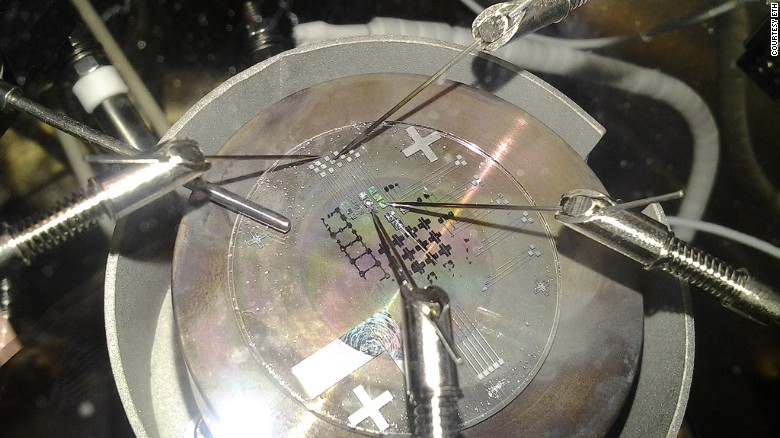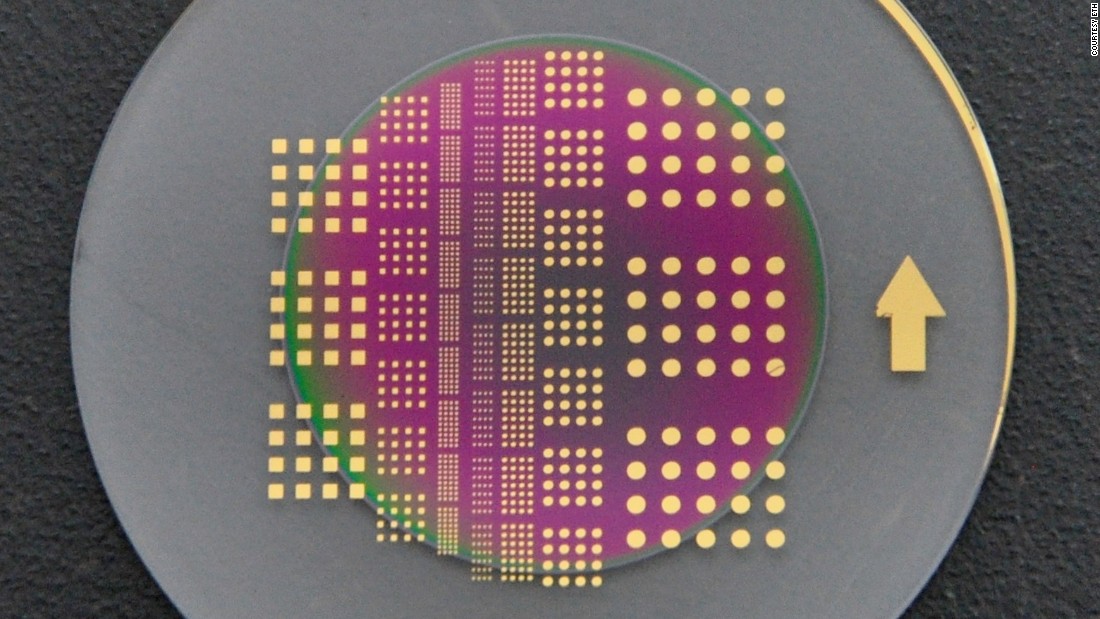It looks like you're using an Ad Blocker.
Please white-list or disable AboveTopSecret.com in your ad-blocking tool.
Thank you.
Some features of ATS will be disabled while you continue to use an ad-blocker.
10
share:
From CNN

Memristors were conceptualized in 1971 but the first one was only built 37 years later,

The Memristor built by HP Labs

A scanning electron microscope view of memristors
Is this a prerequisite to the "Singularity"?
Meet HP Labs Research Scientist John Paul Strachan and hear him talk about how memristors work, demonstrate them in action and their performance.
I think this is the tech that will lead scientists to the "Singularity" and A.I. Very Exciting BUT the little voice in my head says we should be VERY VERY careful.
In 1971, a physicist conceptualized the existence of a fourth fundamental element in the electronic circuit, besides the three that were already in use at the time.
His name was Leon Chua and he believed -- for reasons of symmetry -- that an extra component could one day be constructed to join the resistor, the capacitor and the inductor.
Leon Chua
He called it "memristor", a portmanteau of the words memory and resistor.
It took 37 years for our engineering abilities to catch up with that idea: the first memristor was built by Hewlett Packard in 2008.
And today, many researchers believe it could spark a revolution in computing.

Memristors were conceptualized in 1971 but the first one was only built 37 years later,

The Memristor built by HP Labs
Simply put, the memristor could mean the end of electronics as we know it and the beginning of a new era called "ionics".
The transistor, developed in 1947, is the main component of computer chips. It functions using a flow of electrons, whereas the memristor couples the electrons with ions, or electrically charged atoms.
In a transistor, once the flow of electrons is interrupted by, say, cutting the power, all information is lost. But a memristor can remember the amount of charge that was flowing through it, and much like a memory stick it will retain the data even when the power is turned off.
This can pave the way for computers that will instantly turn on and off like a light bulb and never lose data: the RAM, or memory, will no longer be erased when the machine is turned off, without the need to save anything to hard drives as with current technology.
But memristors have another fundamental difference compared with transistors: they can escape the boundaries of binary code.

A scanning electron microscope view of memristors
Initially, the technology will be mostly used to create super-fast memory chips that contain more data and consume less energy. This alone would make regular computers much more powerful, but down the line, the memristor could also take on the processing.
Jennifer Rupp is a Professor of electrochemical materials at ETH Zurich, and she's working with IBM to built a memristor-based machine within the next two years.
Memristors, she points out, function in a way that is similar to a human brain: "Unlike a transistor, which is based on binary codes, a memristor can have multi-levels. You could have several states, let's say zero, one half, one quarter, one third, and so on, and that gives us a very powerful new perspective on how our computers may develop in the future," she told CNN's Nick Glass.
Such a shift in computing methodology would allow us to create "smart" computers that operate in a way reminiscent of the synapses in our brains.
Free from the limitations of the 0s and 1s, these more powerful computers would be able to learn and make decisions, ultimately getting us one step closer to creating human-like artificial intelligence.
In 1975, Gordon Moore, the co-founder of Intel, formulated a famous law which states that the number of transistors in an electronic circuit doubles approximately every two years.
This has so far proven accurate and set the pace for the constant increase in computing power, but the trend might soon come to an end.
There is a physical limit to the number of transistors that we can pack on a chip, and we are already approaching the miniaturization threshold of this technology. It is inevitable that, one day, we will need to move away from silicon based computing.
The memristor technology is a candidate for this crucial step: "It could mean the end of the silicon era, giving us lower power consumption, the ability to compute more information, increased data storage and completely new logic patterns for our computers," says Rupp.
Memristors don't require a silicon layer and different materials can be used as a substrate. This could create a new class of microchips, that could eventually be integrated in everyday items such as windows, clothes or even coffee cups.
Is this a prerequisite to the "Singularity"?
After manufacturing the first ever memristor, Hewlett Packard has been working for years on a new type of computer based on the technology. According to plans, it will launch by 2020.
Simply called "The Machine", it uses "electrons for processing, photons for communication, and ions for storage."
"I think there is a race going on," says Rupp. "There is a strong driving force, but at the same time it's very important that there are players like HP, because they want to get to the market, show everyone that this is real."
At the moment, manufacturing costs are still high, but the benefits are worth it: "Memristors operate at a lower power consumption, with a faster speed, and with a higher volume density of information than anything we have based on silicon microchip transistors," Rupp told CNN.
Much like a particle in the realm of physics, the existence of the memristor was theorized long before we could actually build one.
Now that we have that capability to manufacture it, the "missing fourth element" of electronics -- despite its less than catchy name -- might be the key to many further human discoveries.
Meet HP Labs Research Scientist John Paul Strachan and hear him talk about how memristors work, demonstrate them in action and their performance.
I think this is the tech that will lead scientists to the "Singularity" and A.I. Very Exciting BUT the little voice in my head says we should be VERY VERY careful.
edit on 2/27/2015 by DjembeJedi because: (no reason given)
a reply to: DjembeJedi
Thanks for the Post DJ.. The first machine is going to roll out around 2020? I may be to old to watch this revolution continue much longer. When I was young we all had a radio in our homes but only a few had TVs, and those with only three stations. I"ve watched all of this come about and it is fascinating to watch society change along with all the tech.
However you say we should be very careful. Indeed so. But there were also those who long ago said that music should only be heard in church and that to paint or draw anything other than Biblical depictions were blasphemy. You a right that we should be very careful but you know what? Not only is this advancement of technology a pandora's box, I think that life itself is a pandora's box and it is to late to put anything back into it. What will be will be.
Thanks for the Post DJ.. The first machine is going to roll out around 2020? I may be to old to watch this revolution continue much longer. When I was young we all had a radio in our homes but only a few had TVs, and those with only three stations. I"ve watched all of this come about and it is fascinating to watch society change along with all the tech.
However you say we should be very careful. Indeed so. But there were also those who long ago said that music should only be heard in church and that to paint or draw anything other than Biblical depictions were blasphemy. You a right that we should be very careful but you know what? Not only is this advancement of technology a pandora's box, I think that life itself is a pandora's box and it is to late to put anything back into it. What will be will be.
a reply to: DjembeJedi
If this does end up leading to A.I. we may look back at this moment in the future, and say 'that's where it all went wrong for humanity' :p
If this does end up leading to A.I. we may look back at this moment in the future, and say 'that's where it all went wrong for humanity' :p
I could see this technology becoming exactly what A.I would need to become as close to a human. Allowing the machine to have memory, and increasing
all sorts of computing etc... Amazing tech, unfortunetly the military will gobble this tech up and use it for weapons.
Amazing advance in the science of computing!
good on ya for posting!
This is exciting stuff.....
Of course the implications go far beyond our current computers and AI is looking very possible with this fourth player on the scene.....your caution at the end is very tellingly appropriate too......
What this all means to such endeavours as interpreting data already gleaned by Tevitron, LHC, and countless other data gathering experiments is potentially a revolution in itself.....without new experimental advances in the meantime....
Such things a computer modelling the future may get a kick in the pants they never expected otherwise......
thanks for your informative post.....that's the spirit of ATS!
good on ya for posting!
This is exciting stuff.....
Of course the implications go far beyond our current computers and AI is looking very possible with this fourth player on the scene.....your caution at the end is very tellingly appropriate too......
What this all means to such endeavours as interpreting data already gleaned by Tevitron, LHC, and countless other data gathering experiments is potentially a revolution in itself.....without new experimental advances in the meantime....
Such things a computer modelling the future may get a kick in the pants they never expected otherwise......
thanks for your informative post.....that's the spirit of ATS!
a reply to: DjembeJedi
Interesting.
This ought to advance Digital Intelligence.
a memristor can store information more precisely than the bits on which previous computer processors have been based. Both a memristor and a bit work with electrical impulses. However, a bit does not allow any fine adjustment – it can only work with ‘on’ and ‘off’. In contrast, a memristor can raise or lower its resistance continuously. This is how memristors deliver a basis for the gradual learning and forgetting of an artificial brain.
function in a way that is similar to a human brain: "Unlike a transistor, which is based on binary codes, a memristor can have multi-levels. You could have several states, let's say zero, one half, one quarter, one third, and so on, and that gives us a very powerful new perspective on how our computers may develop in the future," she told CNN's Nick Glass.
Such a shift in computing methodology would allow us to create "smart" computers that operate in a way reminiscent of the synapses in our brains.
Interesting.
In 2012, Crupi, Pradhan and Tozer described a proof of concept design to create neural synaptic memory circuits using organic ion-based memristors. Using a grid of circuits, a pattern of light was stored and later recalled. This mimics the behavior of the V1 neurons in the primary visual cortex that act as spatiotemporal filters that process visual signals such as edges and moving lines
This ought to advance Digital Intelligence.
Memristors are made of fine nanolayers and can be used to connect electric circuits. For several years now, the memristor has been considered to be the electronic equivalent of the synapse. Synapses are, so to speak, the bridges across which nerve cells (neurons) contact each other. Their connections increase in strength the more often they are used. Usually, one nerve cell is connected to other nerve cells across thousands of synapses.
www.rdmag.com...
a memristor can store information more precisely than the bits on which previous computer processors have been based. Both a memristor and a bit work with electrical impulses. However, a bit does not allow any fine adjustment – it can only work with ‘on’ and ‘off’. In contrast, a memristor can raise or lower its resistance continuously. This is how memristors deliver a basis for the gradual learning and forgetting of an artificial brain.
edit on 27-2-2015 by wasaka because: (no reason given)
SnF!!
This is way cool! This type of info is why I love coming to ATS!
This is way cool! This type of info is why I love coming to ATS!
Hm. This would be Daystrom's "duotronics". We all know what happened with that.
This tech has broad implications and a lot of advances that have been held back due to limitations can now be realized.
I'm actually pretty shocked to learn that the first memristor wasn't produced until 2008. I remember learning about the concept, complete with the
name 'memristor', in electronics class in school about 15 years ago....
originally posted by: AdmireTheDistance
I'm actually pretty shocked to learn that the first memristor wasn't produced until 2008. I remember learning about the concept, complete with the name 'memristor', in electronics class in school about 15 years ago....
I was as well. It was a matter of Tech catching up with Innovation!
a reply to: wasaka
It already sounds like half of the mindless people I meet everyday..lol On and off..this tech will surely surpass there braindead status.
a memristor can store information more precisely than the bits on which previous computer processors have been based. Both a memristor and a bit work with electrical impulses. However, a bit does not allow any fine adjustment – it can only work with ‘on’ and ‘off’. In contrast, a memristor can raise or lower its resistance continuously. This is how memristors deliver a basis for the gradual learning and forgetting of an artificial brain.
It already sounds like half of the mindless people I meet everyday..lol On and off..this tech will surely surpass there braindead status.
new topics
-
Putin, Russia and the Great Architects of the Universe
ATS Skunk Works: 2 hours ago -
A Warning to America: 25 Ways the US is Being Destroyed
New World Order: 7 hours ago
top topics
-
President BIDEN's FBI Raided Donald Trump's Florida Home for OBAMA-NORTH KOREA Documents.
Political Conspiracies: 12 hours ago, 31 flags -
A Warning to America: 25 Ways the US is Being Destroyed
New World Order: 7 hours ago, 13 flags -
Is AI Better Than the Hollywood Elite?
Movies: 14 hours ago, 4 flags -
Maestro Benedetto
Literature: 14 hours ago, 1 flags -
Putin, Russia and the Great Architects of the Universe
ATS Skunk Works: 2 hours ago, 1 flags
active topics
-
Gaza Terrorists Attack US Humanitarian Pier During Construction
Middle East Issues • 45 • : FlyersFan -
A Warning to America: 25 Ways the US is Being Destroyed
New World Order • 15 • : jidnum2 -
Chris Christie Wishes Death Upon Trump and Ramaswamy
Politicians & People • 25 • : RazorV66 -
Skinwalker Ranch and the Mystery 1.6GHz Signal
Aliens and UFOs • 145 • : Ophiuchus1 -
University of Texas Instantly Shuts Down Anti Israel Protests
Education and Media • 273 • : HerbertWest -
Krystalnacht on today's most elite Universities?
Social Issues and Civil Unrest • 6 • : FlyersFan -
Hate makes for strange bedfellows
US Political Madness • 50 • : 19Bones79 -
Weinstein's conviction overturned
Mainstream News • 28 • : burritocat -
Sunak spinning the sickness figures
Other Current Events • 25 • : Ohanka -
Cats Used as Live Bait to Train Ferocious Pitbulls in Illegal NYC Dogfighting
Social Issues and Civil Unrest • 24 • : NoviceStoic4
10

